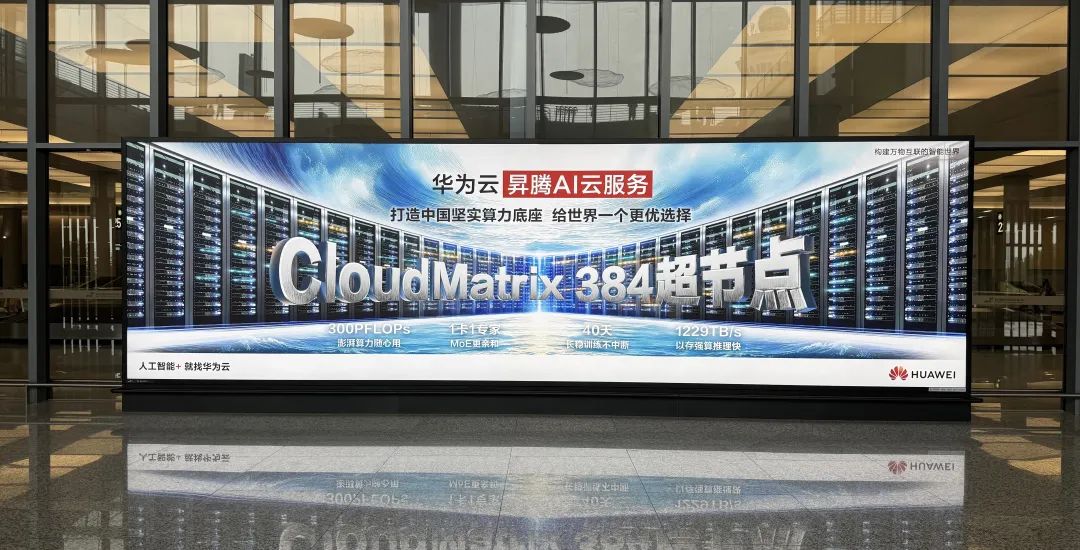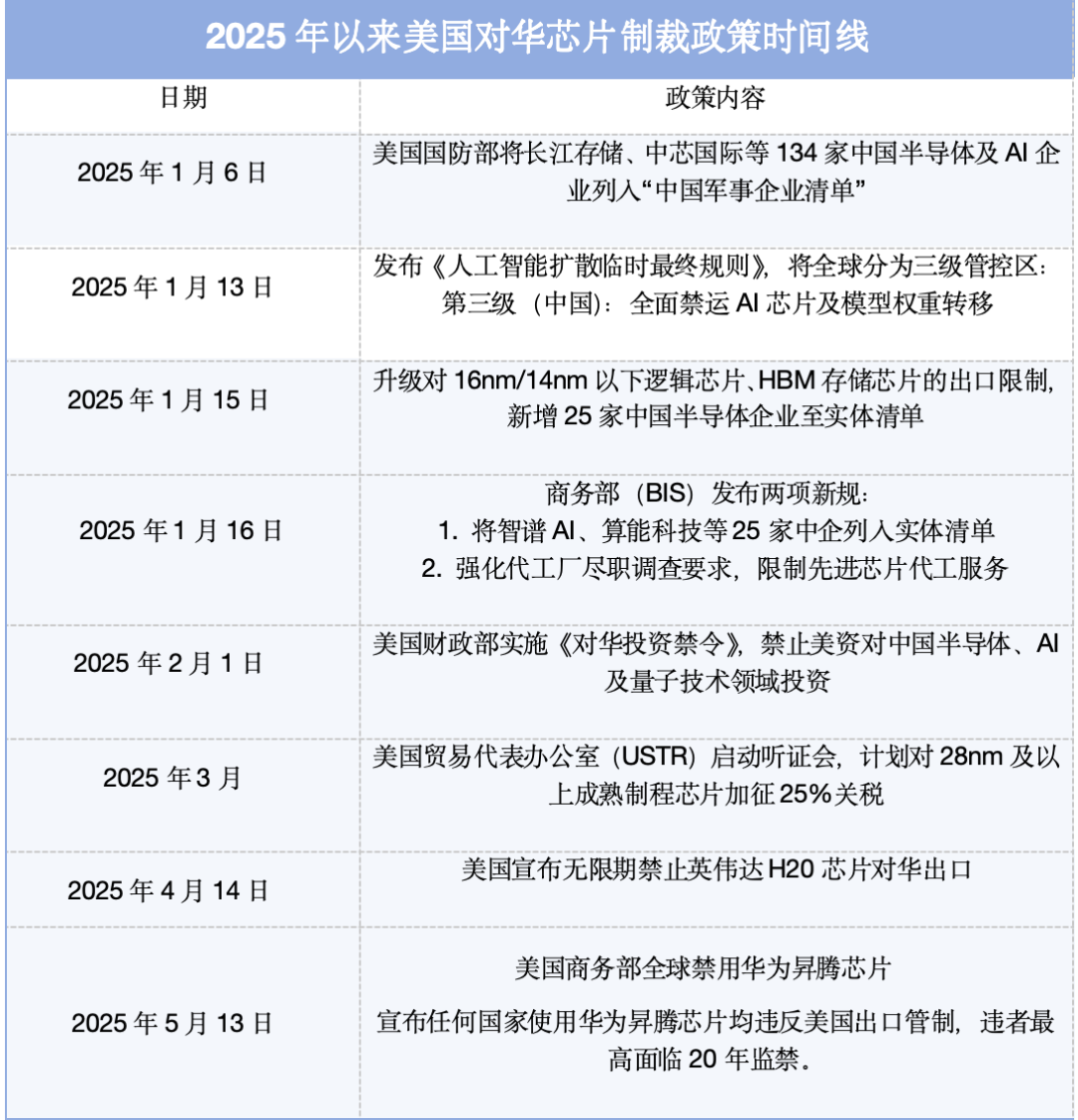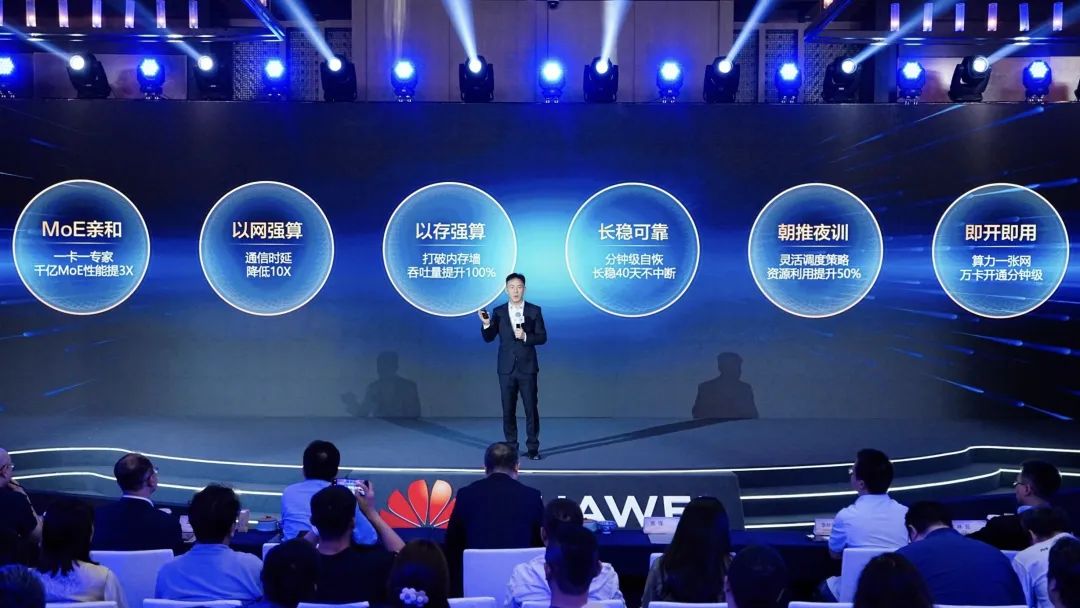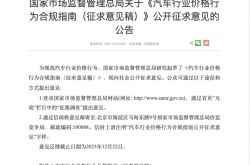Huawei Cloud's secret to breaking through 'sanctions' lies in super nodes
![]() 05/20 2025
05/20 2025
![]() 768
768
Written by | Hao Xin
Edited by | Wang Pan
On April 2, the US initiated a broad tariff assault on the world, playing the 'reciprocal tariff' card.
The policy stipulates that the 10% base tariff will take effect on April 5, while higher tariffs on different trading partners will be implemented from April 9. Subsequently, the US increased the tariff rate on Chinese goods to 145%.
China responded strongly to the US's anti-globalization moves, and the two sides engaged in multiple rounds of negotiations. Finally, on May 11, a temporary outcome was reached. China and the US reached a tariff truce agreement, suspending some additional tariffs, retaining the 10% base tariff rate, and setting a 90-day buffer period.
To curb China's global competitiveness, the US has resorted to a 'combination of tariffs and technology.' On the one hand, it uses tariff levers as a tool for geo-economic competition, and on the other hand, it has escalated the blockade of chip technology into a structural strategic barrier.
From expanding chip export controls and banning the sale of 'China-customized' AI chips such as NVIDIA's H20 and L20, to announcing restrictions such as 'prohibiting the global use of Huawei's Ascend AI chips,' the 'Sword of Damocles' hanging over China's technology industry remains. However, domestic Chinese enterprises remain enthusiastic about AI startups, and large-scale model projects are in full swing.
Under the pressure, Chinese enterprises have not sat idly by. We have observed that since May 14, an advertisement for Huawei Cloud's CloudMatrix 384 super node has begun to dominate airport advertising screens in many parts of China.

It is reported that just last month, Huawei Cloud announced a breakthrough in China's AI field at the Ecological Conference – the CloudMatrix 384 super node. With 384 chips and 300P of computing power, this hardcore technology ends 'computing power anxiety' and showcases the explosive power of Chinese technology to the world.
At a crucial turning point in Sino-US tariffs, what technical confidence does Huawei Cloud imply by placing large-scale airport advertising screens at this time? And what positive signals and industrial values does it release to the industry?
Under heavy pressure, China's technological forces break through
Fearing the rise of China's technological forces, the US has long imposed chip sanctions on China. According to incomplete statistics from Photon Planet, as of May 13, the US has issued eight policies targeting China's chip industry in 2025 alone.

(Photon Planet chart)
Observing the table, the US's chip sanctions against China have three characteristics. First, the technology blockade is gradually becoming more precise, extending from restrictions on chip manufacturing processes to emerging areas such as AI model weights and HBM chips. Second, it curbs the entire chip supply chain, covering all aspects from chip design, manufacturing, packaging, and equipment. Third, it targets key areas precisely, such as imposing a ban on NVIDIA's H20, which as the only compliant AI chip in the Chinese market, effectively blocks China's large-scale model inference needs.
However, if we extend the timeline, we will find that the US's chip sanctions on China did not happen overnight. In formulating sanctions policies against China, the US has repeatedly shown signs of indecision and internal conflict.
Specific examples abound, such as the US's concern about China's AI technology surpassing it while at the same time attempting to maintain market share by easing some restrictions, exposing its contradictory mindset of 'both wanting to contain its rivals and finding it difficult to abandon profits.' In January this year, the US focused sanctions on chips with processes below 16nm/14nm, HBM memory chips, and AI model weights. However, as China's global market share of 28nm chips exceeded 30%, the US proposed to impose tariffs on mature processes of 28nm and above in March, attempting to weaken China's cost advantage.
Despite the US's frequently changing policies on chip sanctions against China, a consensus has gradually emerged recently, namely to abandon a complete decoupling of technology and be forced to shift to precise control of technology, forming a situation of 'peace through resistance.'
The root cause of this 'peace' stems from the rise and breakthroughs of Chinese technology in recent years.
The most prominent is the accelerated process of domestic substitution. Data shows that the localization rate of China's semiconductor equipment has increased from 12% in 2018 to over 40% in 2024. In the field of AI chips, Huawei's Ascend chips are approaching the performance of NVIDIA's. These breakthroughs have rendered the US's 'comprehensive blockade' strategy ineffective, prompting a shift to 'precise restrictions' to retain bargaining chips.
China's technology industry is attempting to convert the pressure of sanctions into a driving force for innovation, ultimately forcing the US to accept a multipolar technology landscape. Essentially, this 'peace' is supported by the continuous breakthroughs in Chinese technology. As a result, China has gained more say in international negotiations.
As is typical of the US, this temporary 'peace' may be broken at any time. Against the backdrop of sanctions that are unpredictable, China's technology industry must always be prepared for danger. Huawei Cloud's launch of the CloudMatrix 384 super node last month is a dual manifestation of technological confidence and innovation.
CloudMatrix 384 Super Node Breaks AI Computing Power Anxiety
In 2019, the US added Huawei to the Entity List of the US Department of Commerce, directly cutting off its supply. In the six years since the sanctions, Huawei has learned to hone cutting-edge technology under high pressure, much like the stormy waves depicted on the advertising screen. However, Huawei Cloud's CloudMatrix 384 super node stands firm like a pillar stabilizing the sea, opening up a path forward.
The CloudMatrix 384 super node is a crucial fortress for Huawei in capturing the AI high ground, serving as the 'terminator' of computing power anxiety.
The term 'super node' has gained popularity in the field of intelligent computing, used to address the computing power issues of large AI models. The core innovation of super node technology lies in its peer-to-peer interconnect architecture. A vivid metaphor is that in traditional architectures, each component is like an isolated island, and data needs to be transferred layer by layer. In contrast, super node technology connects all devices into a continent, allowing data to flow quickly.
Huang Jin, Vice President of Huawei Cloud, pointed out that with the explosive growth in computing power demand for large model training and inference, traditional computing architectures have become difficult to support the intergenerational leap of AI technology. The birth of the super node architecture is not only a technological breakthrough but also a new path for the AI industry through engineering innovation.
Huawei Cloud has launched the CloudMatrix 384 super node with a fully peer-to-peer interconnect architecture. This technology moves beyond the limitations of single-point technology towards a systematic and engineering-based innovative computing power architecture, directly addressing the three major technical challenges of communication efficiency bottlenecks, memory wall constraints, and reliability shortcomings.
There are many 'economic calculations' involved here. In terms of area-to-power and performance, although the performance of a single Ascend chip is one-third that of NVIDIA's Blackwell GPU, the total computing power is increased by 50 times through the cluster scale advantage, providing a maximum computing power of 300 Pflops, which is 67% ahead of similar products in the industry.
As we all know, large models follow 'Moore's Law,' meaning that the larger the model parameters, the faster the performance iteration. However, the larger the parameters, the greater the challenge to hardware and computing power. Considering physical limits, Huawei Cloud's solution is to 'compensate for Moore's Law with non-Moore's Law.' This means enhancing hard power with soft power and building advantages through systematic innovation. Everything can be computed power, 'exchanging space for computing power, bandwidth for computing power, and energy for computing power.'
As an AI infrastructure architecture, the CloudMatrix 384 super node cannot directly provide services externally, making the cloud the best channel. Currently, Huawei Cloud is the only cloud vendor in the industry that uses super node technology with a peer-to-peer architecture to provide computing power services. The Ascend AI Cloud Service serves as its solid foundation, constructing a full-stack independent innovation system from chips to platforms and forming an ecosystem.
Huawei Cloud's CloudMatrix 384 super node boasts six leading technical advantages: MoE affinity, network-enhanced computing, storage-enhanced computing, long-term stability and reliability, day-time inference and night-time training, and instant availability. It redefines the new generation of AI infrastructure through system architecture innovation and provides a new solution to the dilemma of the AI computing power industry.

After DeepSeek's popularity, the demand for DeepSeek-R1 surged among enterprises, but they were unable to deploy and run large models due to technical limitations. In such cases, all-in-one machines became a choice for many, but the mixed quality of these machines only allowed them to serve as 'trial versions,' unable to fully unleash the performance of the full-blooded model.
Super nodes are the optimal choice for the DeepSeek-style MoE architecture. The 'MoE affinity' attribute of CloudMatrix 384 perfectly matches the model deployment requirements. Huang Jin pointed out that compared to the 'small workshop model' of one card with multiple experts, the super node is more like a 'large factory model.' Through a high-speed interconnect bus, it can achieve efficient distributed inference with one card per expert, significantly improving the MoE computation and communication efficiency of a single card. To put it another way, the MoE model is like a 'super team,' where each member (expert) is only good at solving specific problems. However, teamwork requires efficient communication and division of labor; otherwise, it will become chaotic. Huawei Cloud's super node technology serves as the intelligent command center to solve these problems.
The demand for large models from enterprises can be broadly divided into two categories: companies that independently develop and train large models, and companies that have the need to invoke large models.
The former has extremely high requirements for the speed, stability, and computing power available for large model training. The storage-enhanced computing, network-enhanced computing, and long-term stability and reliability of CloudMatrix 384 stand out.
These three functions span the initial, middle, and later stages of large model training.
In the initial data preprocessing and training stages, Huawei Cloud pioneered EMS elastic memory storage. 'Storage-enhanced computing' releases the potential of computing power through storage optimization, solving data loading bottlenecks and memory limitations. You can think of a large model as a human brain with limited capacity. If you have to supplement new knowledge before each exam and retrieve all the knowledge in your brain during the exam, it is a huge waste of time. Huawei Cloud's approach is like an open-book exam, where students are told the answers in advance and can directly copy them when encountering problems, continuously reducing the load on the brain and turning most things into 'knowns.'
'Network-enhanced computing' is mostly used for distributed training of models. When AI computing power moves towards large-scale deployment, the performance of a single chip is no longer the only variable restricting the development of computing power. CloudMatrix 384 upgrades the single-layer network to a two-layer high-speed network through the MatrixLink service, activating the resonance effect of the computing power matrix from point to area, with the core advantage being 'speed.' There are two ideas here: within the super node, it is similar to an elevated highway in a city, avoiding congested red lights and pedestrians and allowing for quick passage, with latency between cards within the super node reduced to the nanosecond level; externally, it is like a highway connecting cities, also prioritizing speed, with latency between super nodes reaching the microsecond level.
'Long-term stability and reliability' is crucial during the disaster recovery stage. This function acts like an 'AI doctor' for fault self-healing, able to check 'symptoms' and perform self-repair at any time. In this regard, Huawei Cloud has developed the Ascend Cloud Brain Operations and Maintenance '1-3-10' standard, which can increase the hardware fault sensing rate from 40% to 90%. Meanwhile, the full-stack fault knowledge base can cover 95% of common problems, greatly shortening the time required for network fault diagnosis. Combined with the 'three-layer fast recovery technology,' it achieves rapid recovery of failures in 10,000-card clusters.
The second category of companies with the need to invoke large models on the cloud can be further divided into enterprises building AI applications and companies implementing vertical scenarios. They may not have the need to train large models from scratch but are generally sensitive to convenience and price.
Currently, the super node can cover 19 major urban agglomerations nationwide through Huawei Cloud's three major computing power hubs. Building an AI cluster often takes three months and is difficult to maintain, whereas accessing the Ascend AI Cloud Service allows for 'instant availability' of computing power, eliminating the need for maintenance and enabling direct access to the latest AI computing power on the cloud, significantly improving efficiency and reducing costs.
In implementing industry scenarios, CloudMatrix 384 utilizes the 'day-time inference and night-time training' elastic scheduling mode to 'save money' for enterprises. Through the two key technologies of 'shared pool for training and inference' and 'flexible scheduling,' it performs model inference during the day and model training during idle nighttime hours, operating efficiently 24 hours a day and increasing the utilization rate of computing resources by more than 30%.
From the upgrade of AI infrastructure to the implementation of cloud service scenarios, 'For AI, choose Huawei Cloud' is no longer just a slogan. The scenes on the advertising screen convey a sense of 'breaking through waves,' implying the search for solutions in the dilemma of being blocked and conveying Huawei's determination to adhere to independent innovation.
The technological race is a marathon
For a cutting-edge technology, advancement is indeed important, but the ultimate measure is whether it serves industrial development and creates social value.
Amid the increasingly complex international environment, the birth of the CloudMatrix 384 super node provides domestic enterprises with a second option besides NVIDIA, which will greatly alleviate their anxiety about future development. Especially for central and state-owned enterprises with computing power procurement needs, safety and stability are overwhelming advantages. Huawei's domestic computing power serves as a 'reassurance pill,' allowing them to proceed with digital and intelligent reforms without hesitation.
Huawei is a microcosm of domestic independent innovation. We can see that Chinese enterprises are not only making breakthroughs in single-point technology and computing power but are also moving towards comprehensive systematic upgrades.
As Zhang Ping'an from Huawei Cloud said, 'When single-point technology is blocked, full-stack collaboration and scale advantages will become the key to breaking the deadlock.'
This means that technology is no longer a one-time deal but a long-term ecosystem project. For example, Huawei has achieved full-chain controllability from hardware to algorithms to avoid dependence on the US CUDA ecosystem. Currently, Chinese technology enterprises must not only participate but also gain a say in the industry and become rule-makers. The value of CloudMatrix 384 goes beyond mere computing power supply; its essence is to reconstruct the AI competition dimension through system-level innovation.
Based on the Ascend AI Cloud Service of CloudMatrix, the latest technological achievements are being introduced into various industries.
Currently, the Ascend AI Cloud Service covers a full-stack solution ranging from computing power services and full-process data governance solutions to large model services and AI toolchains. On the 'AI black soil' created by Huawei Cloud, enterprises can cross the threshold and 'sow' AI innovations with maximum efficiency and minimum cost.
Huang Jin introduced that the Ascend AI Cloud Service has now fully adapted to more than 160 large models, including DeepSeek, assisting customers in model development, training, hosting, and application through cloud services. Since its launch, the Ascend AI Cloud Service has served more than 600 innovative pioneer enterprises in industries such as government, finance, retail, internet, transportation, and manufacturing.
The China-US tariff war has taken a brief recess, but the technological competition between the two countries continues. The technological game is a marathon, and thanks to China's path of independent innovation, many achievements have emerged.
Technologically, DeepSeek represents China's AI's "revenge moment", successfully replicating the performance of OpenAI GPT-3 with ultimate training efficiency and cost-effectiveness, opening up the closed-source "black box". In recent years, the call for embodied intelligence has grown louder, and Unitree Technology has gained popularity through the Spring Festival Gala, with actions such as "in-place backflip", "single-leg joint free control", and "yangko dance" all relying on the adaptive gait generation technology behind it.
From the "Six Little Tigers of AI" to the "Six Little Dragons of Hangzhou", China's enthusiasm for technology entrepreneurship has never been higher. Relevant data shows that last year, the total financing in the artificial intelligence industry exceeded 100 billion yuan, with half of AI companies receiving investments within three years of their establishment.
Technological competition also requires someone to escort and protect it, and CloudMatrix 384 is Huawei Cloud's answer, helping China's future AI industry to move more solidly and steadily.
In this technological game, being first is not an absolute advantage; it relies on perseverance that wears away stone with water droplets and the courage to overcome difficulties. On this basis, latecomers can also rise to the top. Under the new global technological competition landscape, CloudMatrix 384 super nodes will bring new variables to the AI industry and computing power industry.






